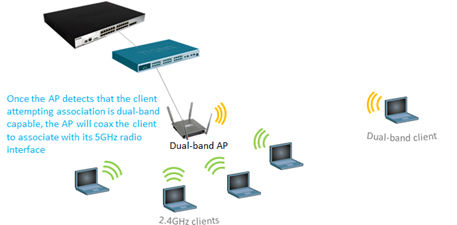Band Steering
As more and more devices are being connected wirelessly in the business environment, the widespread 2.4GHz wireless network performance is not only affected by interference from devices such as cordless phones and Bluetooth devices, but also from completing wireless clients in the same network.
One way to alleviate from this problem is to introduce dual-band capable wireless access points to your network. By creating a separate 5GHz wireless network, you can relieve congestion and overcrowding on the mainstream 2.4GHz frequency wireless network.
However, because the way 802.11 standard works, unless the SSID (wireless network identifier) is different between the 5GHz and the 2.4GHz networks, wireless clients will always connect to the 2.4GHz by default. Most businesses tend to prefer having a homogenous wireless network whereby the SSID is the same and in these instances they may not be getting the most of their dual-band capable wireless network.
Band steering is a technology that detects whether or not the wireless client is dual-band capable, and if it is, it will push the client to connect to the less congested 5GHz network. It does this by actively blocking the client’s attempts to associate with the 2.4GHz network. Since both 802.11n and the latest 802.11ac standards support 5GHz band, band steering can ensure that they achieve their maximum performance without being bottlenecked by legacy 802.11b/g clients. This way, you can make the most of the latest technology and at the same time ensure backwards compatibility with existing legacy equipment.

Band steering is supported in D-Link’s DWL-2690 (hardware version B1) as well as future 802.11ac business wireless access points. It is enabled automatically if or when the SSID of both the 2.4GHz and 5GHz is set the same.
